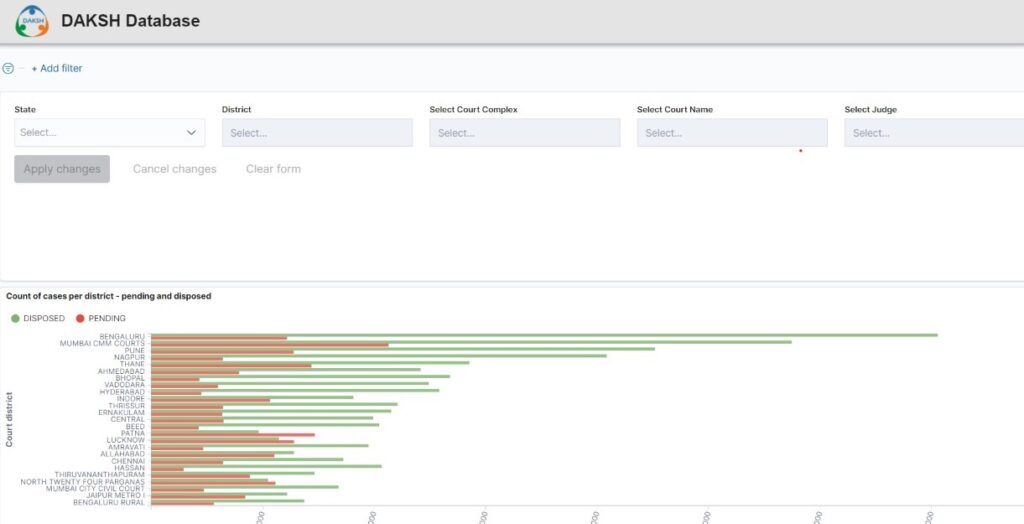

DAKSH High Court Data Portal
The DAKSH database was created in 2015 with the aim of understanding the pendency and age of cases in the Indian judiciary. DAKSH began collecting primary data from the public domain through daily cause lists of six High Courts – Karnataka, Hyderabad, Delhi, Madras, Gujarat, and Orissa – in January 2015. In May 2015, DAKSH expanded the database and began scraping data from the National Judicial Data Grid and eCourts.gov.in on cases in the subordinate judiciary.
DAKSH’s pioneering report titled ‘State of the Indian Judiciary’ was the first to publish analyses of aggregated case information from the DAKSH database, and stressed the need for a data driven discourse to understand the functioning of the judiciary. ‘Approaches to Justice in India’ took forward the discussion in further analysing the problems of pendency and delays in the Indian judicial system.
Inadequate judicial data has long been hindering evidence-based judicial reforms in India. With the creation of the National Judicial Data Grid and eCourts, there has been a huge step forward as data regarding cases and hearings is now available. However, such publicly available judicial data is not in a useable form. The DAKSH database aims to bridge this gap by making publicly available data regarding cases in the subordinate courts and High Courts in an analysable format.
There are two levels of data in DAKSH’s database:
Case Level – Information related to a case. Example: Case Number, Status, Act/Section, etc.
Hearing Level – Information regarding hearings of cases. Example: Hearing date, Stage, etc.
In order to make judicial data easily understandable and to enable any person to be able to analyse this data as per their needs, the data from DAKSH’s database is now available in a new and improved platform accessible here.

DAKSH has also curated specialised dashboards to analyse case progress for specific types of cases:
(1) cases filed under the Protection of Children from Sexual Offences Act, 2012, and
(2) cases filed under the Juvenile Justice (Care and Protection of Children) Act, 2015.
These dashboards have been created based on cases identified through specific case types used for such cases on the eCourts website. As all courts across the country do not provide distinct case types for such cases, the dashboards are limited to cases that were possible to be identified on the basis of distinct case types.
The specialised dashboards can be viewed here:
Click here for the dashboard on POCSO cases
Click here for the dashboard on juvenile justice cases
Click here for the dashboard on domestic violence cases
A data dictionary for the terms used in the data is provided here.
If you have any questions or concerns, or any feedback regarding the DAKSH database or the platform, please write to us at info@dakshindia.org
Disclaimer: The analyses shown on the platform emerge from primary data collected from eCourts, NJDG, and the websites of High Courts in India. While all efforts have been made to ensure the completeness of information, there are gaps in the data that was available, which may impact our findings. Any inadvertent errors in the analyses are those of DAKSH alone. The DAKSH database seeks to make data regarding the judiciary publicly available in an analysable format for easy access and use by all stakeholders in the justice system to understand the functioning of the judiciary.
RECENT ARTICLES


Decoding Judicial Policy 3

Decoding Judicial Policy 1

Decoding Judicial Policy

-
Rule of Law ProjectRule of Law Project
-
Access to Justice SurveyAccess to Justice Survey
-
BlogBlog
-
Contact UsContact Us
-
Statistics and ReportsStatistics and Reports
© 2021 DAKSH India. All rights reserved
Powered by Oy Media Solutions
Designed by GGWP Design